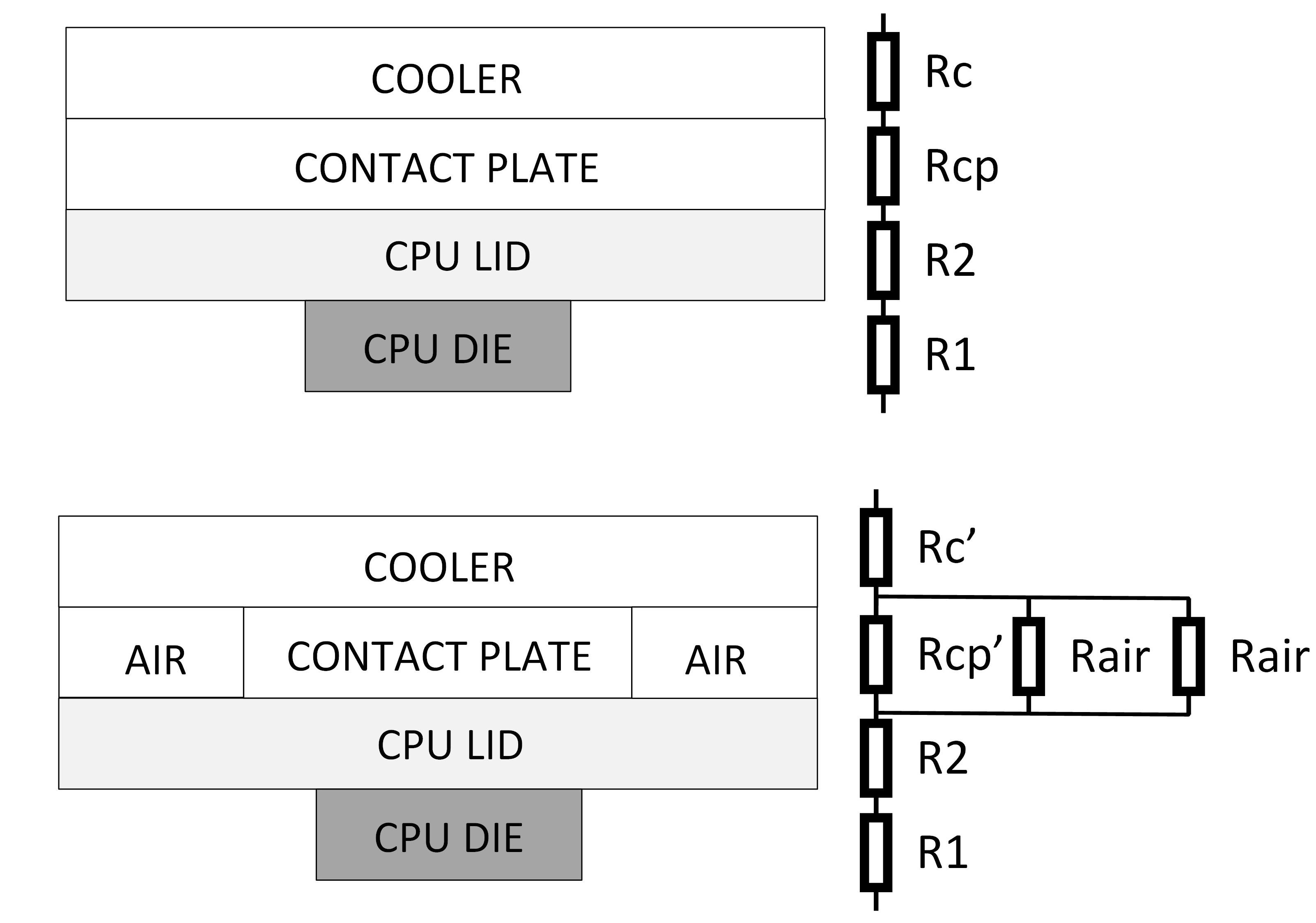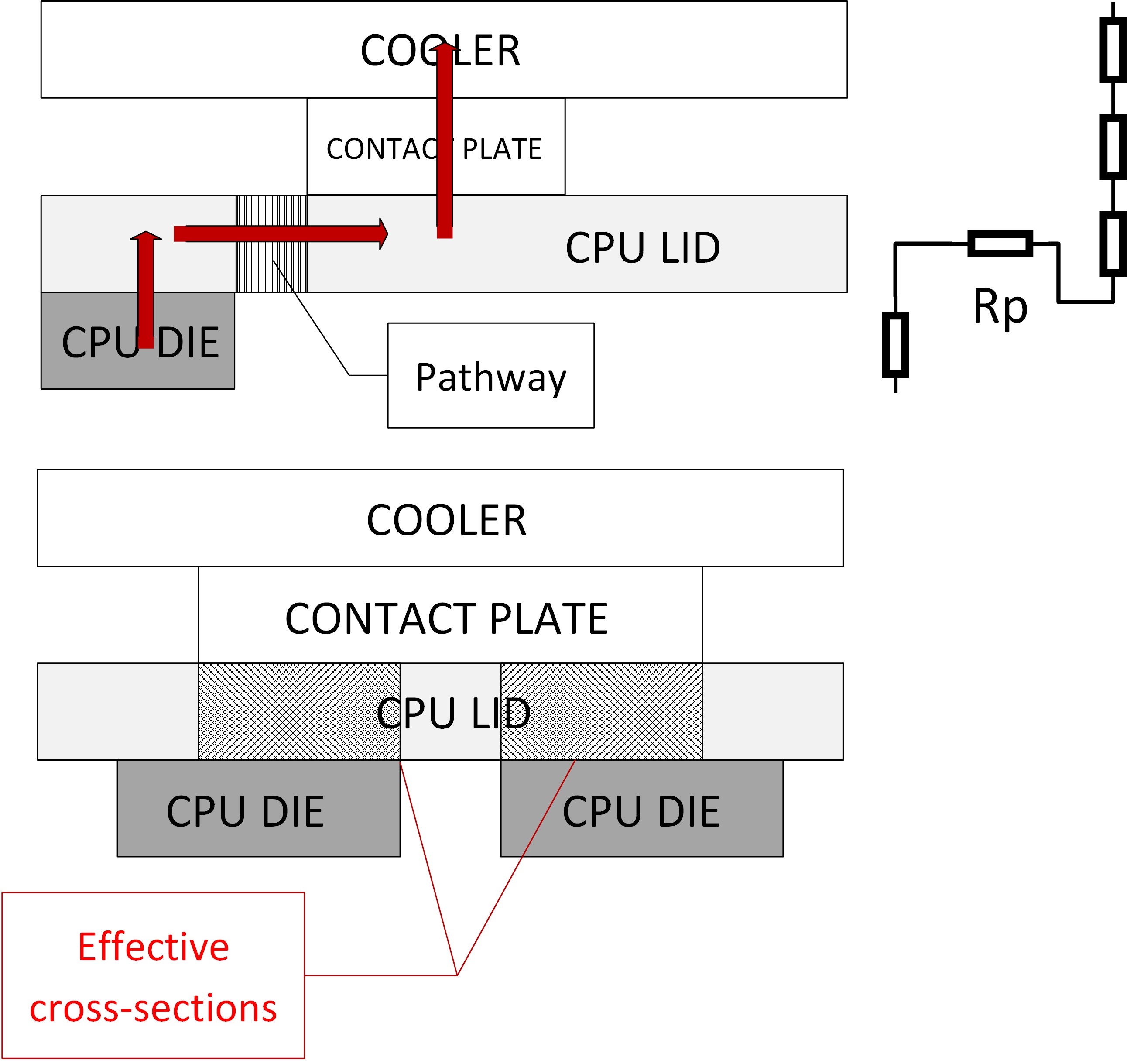Analyzing Threadripper Thermals: Big Base Cooling Wins
by E. Fylladitakis on March 14, 2018 8:30 AM EST- Posted in
- CPUs
- AMD
- Cases/Cooling/PSUs
- Noctua
- ThreadRipper
- 1950X
- CPU cooler
AMD Threadripper Processors & Cooler Compatibility
In the case of AMD’s Threadripper processors, it is the third part of the CPU/Cooler arrangement that causes concerns, i.e. the coolers themselves. As we mentioned earlier, one of the major factors that affects the thermal resistance of each individual part is the cross-sectional contact area. As an extreme example, even if we could devise an ideal cooling body that has zero thermal resistance to place upon a copper contact plate, it would be ineffective if the contact plate is reduced to the size of a pinhead.
In the above figure, we split a cooler into two parts for a quick, simplified model. The first part is the contact plate and the second is the rest of the cooler. In that case, the cooler’s thermal resistance (R3) is split into two individual resistances (Rcp and Rc). If nothing were to change from before, R3 would be equal to Rcp + Rc. However, via simple math and considering heat conduction via air to be negligible, it can be derived that reducing the cross-sectional surface area of the contact plate will significantly increase its absolute thermal resistance and, in turn, the thermal resistance of the entire arrangement.
Consequently, assuming that we have the exact same CPU, lid, and cooling body, an undersized cooler’s contact plate that does not make full contact with the lid will significantly increase the thermal resistance of the whole arrangement. Furthermore, no matter how good absolute thermal resistance the cooler’s main body may have, even if we were to consider a hypothetical ideal cooler with no thermal resistance at all, the rest of the resistances are still being added to the sum that governs the total thermal conductance of the arrangement. The high thermal resistance caused by an undersized contact plate cannot be easily countered, which is why the thermal conductance of the cooler itself needs to be very high, i.e. why AMD’s cooler recommendations are so over the top.
Our previous calculations are representative of the real-world phenomena but also were based on our greatly simplified assumptions, assuming uniform heat transfer and one-dimensional conduction. A trained engineer easily realizes that real-world issues with coolers that are making only partial contact with a CPU’s lid are numerous and that they extend far beyond simple everyday thermal performance. For example, the absolute thermal resistance between the CPU dies that lie away from where the cooler is contacting the lid and the cooler’s base is manyfold greater. That is because the two primary geometric factors that affect thermal resistance, the length of the material in parallel to the heat flow and it's the cross-sectional contact area, are now greatly different.
The above figure displays two cases. In the bottom case, the contact plate of the cooler is not sufficiently large to cover the entire CPU lid, leaving part of the CPU’s dies outside the “effective” heat transfer cross-sections. This does not mean that the rest of the die does not receive any cooling - the CPU's lid will keep absorbing energy from the whole die, but the heat flow ceases to be simple one-dimensional and the distribution will not be uniform, resulting to higher temperatures near the edges of the lid and, in extend, the outermost parts of the die.
The top case is a more extreme example and assumes that a die will be left entirely outside the surface where the cooler's contact plate will be. In this case, there is no “effective” heat transfer cross-section at all and it is practically impossible to properly cool the device. Again, simplifying and solving the problem as one-dimensional is possible by splitting the process into numerous steps and taking one step at the time. We skip most of these steps and go right to the important one. As it can be seen in the above figure, the thermal resistance of the "pathway" created between the die and the contact plate is being added to the total absolute thermal resistance of the arrangement. However, the cross-sectional area of this "pathway" is very small because the thickness of the lid is comparatively tiny. This results to a massively high resistance (Rp) that will be added to the sum and cannot be effectively countered no matter how good the cooler may be.
The above two examples show that any die which is partially covered or, far worse, not covered at all by the cooler’s contact surface, may be prone to overheating and reliability issues, even if the processor’s central dies are being cooled properly, and regardless of the cooler's capabilities.












43 Comments
View All Comments
FireSnake - Wednesday, March 14, 2018 - link
Awesome review, thank you!iter - Wednesday, March 14, 2018 - link
Hmm, the cooler should cover the chip it is cooling... who would have thought that to be the case?"AMD’s Threadripper processors certainly do not require liquid coolers to function properly at stock"
Moot point, as nigh end noctua coolers easily beat AIO water coolers and can only be marginally bested by significant custom loop systems.
Finally, it might have been a good idea for amd to invest in a third socket for dual die chips. Sure they saved some money on underusing SP3 for TR, but that might have backfired more than the savings - the socket is huge, complex and expessive, takes up too much space, limits mobo designs and a lot of users report serious problems with the installation. On top of rendering existing coolers rather inefficient, something that would not have been a problem with a dual die socket.
ravyne - Wednesday, March 14, 2018 - link
I wager we might see AMD introduce a new socket with Threadripper being a success. It's been reported that TR was essentially a passion-project for the engineers and so they didn't have the full resources at their disposal, even if they had the blessing of execs. There's the Epyc embedded 3000 series just coming out, which is a 1-or-2-die package supporting full PCIe lane potential and quad-channel memory in the two-die configuration, but it's designed to be soldered. Perhaps we'll see a socketed version, which would make ITX form factors possible and uATX more comfortable, and possibly reduce motherboard socket costs. I think they've committed to supporting the current TR socket for 3 generations of CPUs, but supporting two different sockets shouldn't be overly difficult given the multi-die/interposer construction and being able to leverage similarities/economies-of-scale with Epic 7000. Plus, if mainstream core counts continue to increase we're gonna need more PCIe and DRAM channels anyway, so maybe this just becomes the new mainstream socket.eek2121 - Wednesday, March 21, 2018 - link
We won't see a new socket for a while. Threadripper was a HUGE success and AMD wants to keep the Gravy Train rolling. I bought an Enermax 360 for mine and even when overclocked to 4.1 the machine runs silent and cool.Martin Malice - Thursday, April 19, 2018 - link
I have Enermax 360, I'm having troubles with cooling. Idk why but my Threadripper can't fall below 45 degrees Celsius when I'm working. When I start rendering something the temp goes up to 68 and clock speed starts dropping down. I don't know what's the problem, I've re-applied the thermal paste recently but the problem went away just for a short time and then it slowly reappeared.Alexvrb - Wednesday, March 14, 2018 - link
Not sure how you could have "serious problems" with the install. I for one like the overbuilt socket. I mean, unless you're one of the strange people aiming for an ITX TR build.I don't have any plans to own a TR system for personal use... I don't need more than 8 cores, quad channel RAM, or a crapload of PCIe lanes. But if you do it's a decent platform, and relatively affordable.
eek2121 - Wednesday, March 21, 2018 - link
I would love to see them make a mobile variant.LostWander - Thursday, March 15, 2018 - link
No need for the hate. It's an obvious conclusion but it's nice to have some of the "why" laid out so well for those of us with only introductory engineering knowledge.iter - Thursday, March 15, 2018 - link
I wasn't aware that it takes engineering knowledge, introductory or otherwise, to possess common sense. "Contact" IMO is a pretty intuitive and self-explanatory concept...Yet it seems certain overly sensitive individuals have put emphasis on developing nonsensical sensibilities and neglected developing precious common sense... To the point of misidentifying sarcasm as "hate"... It is not hate, it is simply not being a dumb robot person whose worldview is so narrow that literally techniques slip outside of his norms for "appropriate"...
I for one don't find it all that positive that people need such things explained in the first place, it is rather alarming to say the least.
LostWander - Thursday, March 15, 2018 - link
Lots of assumptions there friend. Really sad honestly there were a lot of better (and more accurate) interpretations of my comment available.I'm so sorry for anyone in your life. Get help for their sake.